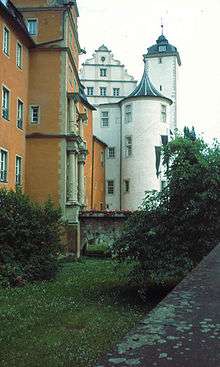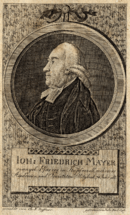Bad Mergentheim
| Bad Mergentheim | ||
|---|---|---|
 | ||
| ||
 Bad Mergentheim | ||
Location of Bad Mergentheim within Main-Tauber-Kreis district  | ||
| Coordinates: 49°30′0″N 9°46′0″E / 49.50000°N 9.76667°ECoordinates: 49°30′0″N 9°46′0″E / 49.50000°N 9.76667°E | ||
| Country | Germany | |
| State | Baden-Württemberg | |
| Admin. region | Stuttgart | |
| District | Main-Tauber-Kreis | |
| Government | ||
| • Lord Mayor | Udo Glatthaar (CDU) | |
| Area | ||
| • Total | 129.97 km2 (50.18 sq mi) | |
| Population (2015-12-31)[1] | ||
| • Total | 23,064 | |
| • Density | 180/km2 (460/sq mi) | |
| Time zone | CET/CEST (UTC+1/+2) | |
| Postal codes | 97980 | |
| Dialling codes | 07931 (primarily), 07930, 07932, 07937, 07938 (boroughs) | |
| Vehicle registration |
TBB, MGH MGH (registered again) | |
| Website | www.bad-mergentheim.de | |
Bad Mergentheim (![]() listen ; Mergentheim until 1926; East Franconian: Märchedol) is a town in the district Main-Tauber-Kreis district in the German state of Baden-Württemberg.
listen ; Mergentheim until 1926; East Franconian: Märchedol) is a town in the district Main-Tauber-Kreis district in the German state of Baden-Württemberg.
History
Mergentheim is mentioned in chronicles as early as 1058, as the residence of the family of the counts of Hohenlohe, who early in the 13th century assigned the greater part of their estates in and around Mergentheim to the Teutonic order. In 1340 Mergentheim got Town privileges. It rapidly increased in fame, and became the most important of the eleven commanderies of that society. On the secularization of the Teutonic Order in Prussia in 1525, Mergentheim became the residence of the grand master, and remained so until the final dissolution of the order in 1809 by Napoleon.[2]
Bad Mergentheim's fortunes were reversed in 1826, when a shepherd by the name of Franz Gehring discovered rich mineral springs in the surrounding area, during the time when spas were expanding in Germany at a rapid pace. The water turned out to be the strongest sodium-sulfate water in all of Europe, especially effective for the treatment of digestive disorders.
In the 1970s several neighbouring villages were incorporated during the "Gemeindereform".
| Year | Population |
|---|---|
| 1660 | 1,064 |
| 1855 | 2,917 |
| 1900 | 4,372 |
| 1933 | 6,191 |
| 1945 | 9,300 |
| 1950 | 10,184 |
| 1961 | 11,608 |
| 1975 | 19,895 |
| 1990 | 21,567 |
| 2005 | 22,486 |
| 2013 | 22,470 |
Villages
(inhabitants)
Althausen (600), Apfelbach (350), Dainbach (370), Edelfingen (1.400), Hachtel (360), Herbsthausen (200), Löffelstelzen (1,000), Markelsheim (2,000), Neunkirchen (1,000), Rengershausen (480), Rot (260), Stuppach (680), Wachbach (1,300)
Main sights


The most interesting sight in Bad Mergentheim is the Deutschordensschloss, the medieval castle where the Teutonic Knights once had their home base. It is a complex of buildings built over a period of eight hundred years. The first buildings of the castle were probably erected as early as the 12th century. The castle was expanded in the late 16th century under Grand Master Walter von Cronberg. Over the course of time a representative Renaissance complex was built by connecting the individual buildings in the inner palace courtyard to a closed ring of buildings. In 1574, the main architect, Blasius Berwart, also constructed the spiral staircase between the west and north wing still famous today. Today the castle houses the Deutschordensmuseum (Museum of the Teutonic Order).
The castle complex is dominated by the Schlosskirche (Castle Church), built in 1730 in Baroque style. Its Rococo interior features elaborate ceiling frescos by the court painter Nikolaus Gottfried Stuber, depicting The Defense of Faith, the Glorification of the Cross in Heaven and on Earth and the Emperor Constantine's Vision of the Cross. Almost 200 years ago the Schlosskirche became a Protestant church.

Modern facilities
Twin towns — sister cities
Bad Mergentheim is twinned with:
-
 Digne-les-Bains, France
Digne-les-Bains, France -
 Sainte-Marie-du-Mont, Manche, France
Sainte-Marie-du-Mont, Manche, France -
 Fuefuki, Yamanashi, Japan[3]
Fuefuki, Yamanashi, Japan[3] -
 Borgomanero, Italy
Borgomanero, Italy
Notable residents and natives
- Heinrich von Hohenlohe, (died 1249), buried in the church in Mergentheim
- Johann Böhm (1528–1560), German religious priest and writer

- Johann Friedrich Mayer (agriculturist) (1719–1798), priest and agricultural reformer ( "Plaster Apostle")
- Ludwig van Beethoven, (1770–1827), was viola player in the court's musical establishment of the Hochmeister (Grand Master) of the Teutonic Knights Maximilian Franz of Austria in 1791.
- Hermann Bauer (1814–1872), Protestant pastor and one of the most important Württemberg local historians in the 19th century
- Eduard Mörike, (1804–1875), German poet, lived in Bad Mergentheim from 1844-1851.
- Fritz Keller (1850–1923), member of parliament, president of the Württembergi Forest Office
- Franz Conrad von Hötzendorf, (1852–1925), Austro-Hungarian Field Marshall from 1871-1918, died in Bad Mergentheim

- Ottmar Mergenthaler, (1854–1899), inventor of the Linotype[4]
- Edvard Hjelt, (1855–1921), Finnish chemist and politician, died in Bad Mergentheim
- Felix Fechenbach, (1894–1933) German Jewish journalist, poet and political activist, who was murdered by the Nazis
- Gudrun Mebs (born 1944), writer, children's and youth book author (Deutscher Jugendliteraturpreis 1984)
- Barbara Stamm (born 1944), politician CSU, President of the Bavarian Parliament
- Fritz Kuhn (born 1955), Lord mayor of Stuttgart, former Member of Parliament and former National Chairman of the Greens
- Jürgen Koch (born 1963), cook, awarded one star in the Michelin
- Martin Lanig (born 1984), football player
- Carolin Golubytskyi (born 1985), foil fencer
- Atilla Yildirim (born 1990), Dutch-Turkish footballer
- Florian Ruck (born 1992), football player
See also
Notes
- ↑ "Gemeinden in Deutschland nach Fläche, Bevölkerung und Postleitzahl am 30.09.2016". Statistisches Bundesamt (in German). 2016.
- ↑
 One or more of the preceding sentences incorporates text from a publication now in the public domain: Chisholm, Hugh, ed. (1911). "Mergentheim". Encyclopædia Britannica. 18 (11th ed.). Cambridge University Press. p. 164.. Additional citations:
One or more of the preceding sentences incorporates text from a publication now in the public domain: Chisholm, Hugh, ed. (1911). "Mergentheim". Encyclopædia Britannica. 18 (11th ed.). Cambridge University Press. p. 164.. Additional citations:
- Höring, Das Karlsbad bei Mergentheim (Mergentheim 1887); and
- Schmitt, Garnisongeschichte der Stadt Mergentheim (Stuttgart, 1895).
- ↑ "International Exchange". List of Affiliation Partners within Prefectures. Council of Local Authorities for International Relations (CLAIR). Retrieved 21 November 2015.
- ↑ Who Was Who in America, Historical Volume, 1607-1896. Chicago: Marquis Who's Who. 1963.
External links
| Wikivoyage has a travel guide for Bad Mergentheim. |
-
 Media related to Bad Mergentheim at Wikimedia Commons
Media related to Bad Mergentheim at Wikimedia Commons

